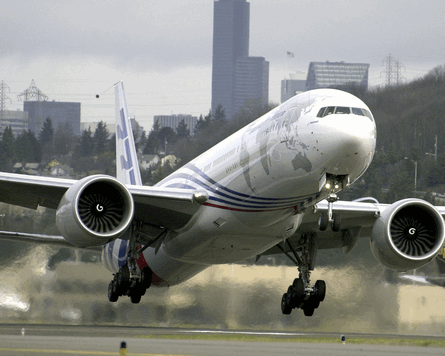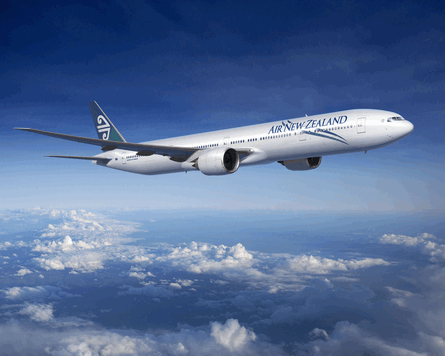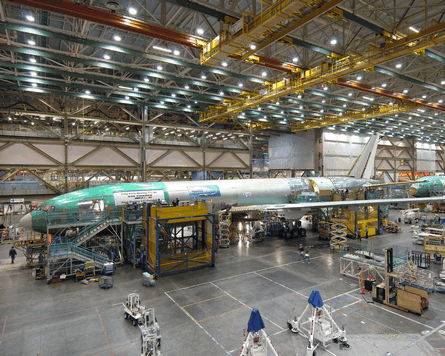Boeing's 777 has come a long way since its arrival in 1995, with the recent roll-out of a freighter version and the -300ER's popularity as a highly fuel-efficient airliner
In recent years, the aviation industry has been on the receiving end of an onslaught of demands to improve its environmental record. Accounting for 2% of global carbon emissions, the industry was forced to respond by demonstrating exactly what was being done to cut the burning of fossil fuels. By the 2007 Paris air show, "being green" was at the centre of the industry's message.
With the apogee of the price of oil still out of sight, the fate of the industry will remain inescapably bound to this natural resource.
For airlines, reducing fuel burn not only means reducing carbon emissions, but guarding the bottom line. One year later, as the 2008 Farnborough air show gets under way, the message of "being green" has evolved into the centrepiece of a sustainable business model. As a result, older long-range aircraft are being retired in favour of current-generation aircraft.
"There is no bigger incentive than the price of oil," says Paul Steele, director of aviation environment for the International Air Transport Association.
 |
|---|
© Boeing |
Twin Benefits
With the necessity for improved fuel burn, Boeing continues to reap the benefits with its large twin-engine, long-range 777 family. For example, Air New Zealand has announced that it is reducing capacity on its popular Auckland-Los Angeles-London route by switching from the four-engined 747-400 to newer 777-200ERs.
"We sacrifice about a sixth of our seats to reduce our fuel burn by about a third," says Air New Zealand chief executive Rob Fyfe. On ultra-long-haul trips for Air New Zealand, fuel accounts for 65% of the operating cost of the 747-400. "The economic opportunity associated with using far more fuel-efficient aircraft is phenomenal," Fyfe says. The saving, Fyfe speculates, is about NZ$100 million ($75.9 million).
Air New Zealand will eventually replace its 777-200ER with the -300ER on that route when those aircraft begin to arrive in 2010. The airline plans to operate the same-size premium cabin with a small reduction in lower yield economy seating.
 |
|---|
© Boeing |
The high price of oil is both a blessing and a curse for Boeing. On one hand, airlines are eager to retire older, less-efficient aircraft to improve fuel burn and on the other, as fuel costs rise, airlines are finding themselves cutting capacity and consolidating and deferring large aircraft purchases for sunnier days.
Yet, for Boeing, Air New Zealand's story is not unique. Airlines around the world have opted for fuel-sipping GE90-powered 777s to replace older and often larger aircraft.
For Boeing, the backbone of the 777 product line is the 365-seat 777-300ER, which accounted for almost 70% of Boeing's 777 orders in 2007. When the aircraft made its first flight in 2003, the 777-300ER had just seven customers: All Nippon Airways, Air France, EVA Air, GECAS, ILFC, Japan Airlines and Pakistan International Airlines. Today, the 777-300ER has been ordered by more than 25 customers.
Key To Success
One key to its market success has been the steady performance improvement delivered to airline customers. The aircraft has exceeded Boeing's early conservative expectations by leaps and bounds. In 2001, Boeing initially touted a range of 13,275km (7,175nm) for the 777-300ER.
During flight testing in 2003, Boeing's conservative performance forecasts were smashed as the new raked wingtip offered 1.5% better fuel consumption than expected. "The airplane's performance during flight testing has been nothing short of outstanding," said Lars Andersen, programme manager for Boeing 777 Longer Range aircraft in 2003.
In addition, take-off field length was reduced by 300m (1,000ft) because of other new features such as semi-levered landing gear, the tail-strike protection system and improvements in brake performance. At the time, Boeing was able to offer an increased maximum take-off weight of 350,000kg (775,000lb), an improvement of 7,000kg and a boosted range of 14,250km.
Customers for the 777-300ER began ordering modification kits in late 2005 to further improve fuel burn by 1.4%. The kit included revised vortex generators and changes to the ram-air system duct exit. According to Boeing, each 1% fuel saving is equal to roughly 140km extra range, 10 more passengers or 1,090kg of cargo.
The aircraft has continued to mature and improve performance after entering service in 2004 with Air France. The installation of lighter weight interiors has also boosted the range to as much as 14,670km.
Boeing's desire to perpetually improve the 777 has not been limited to the 777-300ER. Boeing officially launched the product improvement package (PIP) for the 777-200/200ER/300 models earlier this year with orders from at least seven customers for 139 aircraft. Twenty-five per cent of the oldest 777 models are to receive the upgrade package, which has been shown to improve fuel efficiency by 1% through the drooping of the outboard ailerons, replacing wing vortex generators and improvements in the ram-air system.
Market Progress
Boeing's 777 programme has enjoyed more than 1,000 orders since it was launched by a 16-aircraft order from United Airlines in October 1990. The 777 has come a long way since the arrival of the "A"-market aircraft in 1995. With five successful variants under its belt, Boeing is now working to bring its sixth 777 to market.
Looking past its role as a passenger aircraft, the 777 has evolved into a freighter. There is perhaps no greater barometer of success for a commercial aircraft programme than when windows are plugged and engineers take the proverbial hacksaw to the fuselage, making way for a cargo door.
The 777F, which is based on the 777-200LR, will enter service by the end of 2008 with Air France Cargo. Like its longer-range siblings, the 777F is powered by two General Electric GE90-110B1L engines each rated at 110,100lb of thrust (490kN). As of May 2008, Boeing had earned 78 orders from 11 customers for 777 Freighter aircraft.
 |
|---|
© Boeing |
The freighter has a range of 9,000km with a volume limit payload at 163kg/m3 (10.2lb/ft3). The main deck has a volume of 518m3 (18,300ft3) and can accommodate 27 pallets and a volume of 118m3 on the lower deck. The maximum revenue payload is 102,600kg. One of the key challenges of the 777F programme was transitioning the 777 final assembly line in Building 40-25 at Everett to a lean manufacturing system, while simultaneously introducing a new variant with different processes and parts, all while maintaining the continuity and output of the line to meet customer timetables.
First Flight
Chief test pilot of the 777 programme, Suzanna Darcy-Henneman, will fly the 777F for the first time this summer. Joining Darcy-Henneman on the flightdeck in the right seat will be test pilot Van Chaney. Eighty per cent of the flight-test programme will test smoke detection and smoke penetration, which is typical of a freighter flight-test programme.
For testing the performance, manoeuvre load alleviation has been built into the flight-control software to move the centre of lift inboard, which reduces the bending moment at the root of the wing, therefore reducing the need for structure that would otherwise be required at higher weights. The system is activated at 44° of bank and works by extending the outboard spoilers and ailerons to move to centre of lift inboard. The surfaces would be slightly extended at 44° and extended one-third in a 66° banked turn.
The flight-test programme will consist of two aircraft, both for Air France Cargo, flown for 300-350h and about double for ground testing. Initially the first 777F, which will wear Boeing colours for the flight-test programme, will fly six days a week, with the seventh for maintenance, with 10 and a half flightcrews responsible for the programme. The second aircraft will fly five days a week and the sixth will be used for maintenance. Ground testing will require a minimum of two crews. Boeing expects the combined 900-1,050 test hours to last around two and a half months.
The first Freighter, which was assembled in Everett, will carry out its flight-test programme from Boeing Field in Seattle. "The airplane will take off out of Paine Field, go up and down the Olympics several times around Mt Rainier for some great beauty shots and into Boeing Field. All the rest of the take-offs and landings will be in and out of Boeing Field," says Darcy-Henneman of the 777F's first flight.
Boeing's record 2007 year for orders saw its 777 backlog grow by 143. Nearly 70% of those orders were for the 777-300ER. The market success of the longer-range 777 has been significant for Boeing.
Airbus, by comparison had a net loss in 2007 for its direct 777 competitor, the four-engined A340. The 777-300ER and 777-200LR have decimated A340-600 and A340-500 sales considerably. Yet, a closer look at the order battle shows that Boeing is in the midst of its first real challenge to its 777 market supremacy with the development of the largely composite Airbus A350 XWB.
Airbus markets its A350 XWB against the 787, yet of the performance and capacity of the three variants offered, only one, the A350-800, competes directly with the 787-9. The two larger A350s, the A350-900 and A350-1000, take on the 777-200ER and 300ER at 314 and 350 seats respectively in a three-class configuration. Boeing has been reluctant to commit to its next steps for the 777, opting for the incremental product improvement packages rather than launch a more expansive upgrade on a next-generation 777 or a even go so far as clean-sheet design to replace the 777 altogether.
The reluctance comes from two equally important sources. First, the longer-range 777s have enjoyed significant sales success with the 777 order total growing over 50% in just the last three years. Orders now top the 1,000 mark and many airlines continue to use the 777-300ER to retire older aircraft. Boeing simply has to ask itself the question, "Why phase out a hot-selling product?"
The second reason originates with the 777's new chief competitor. Airbus's challenges to the 777, the -900 and -1000 A350 variants, lack formal definition and design freeze for the first A350 variant, the -900, is not expected until later this year. The -1000, the third A350 to be introduced, touts a range of 14,800km and a capacity of greater than 350 seats. It challenges the 777-300ER head on. To date, only two airlines, Emirates and Qatar Airways, have ordered the A350-1000. Both are current operators of 777-300ERs.
More strikingly, the A350-900 has effectively attacked Boeing's 777-200ER. Only 11 of the 143 777 orders in 2007 were for the 777-200ER. In contrast, the A350-900 received 118 gross orders in 2007. Airbus claims the A350-900 will offer a 25% improvement in cash operating costs and a 30% improvement in block fuel per seats over Boeing's 777-200ER.
Before answering the question about how to respond to the market threat to the 777-300ER, Boeing must first determine how to react to its loss of market share in the long-range 300-seat segment.
787 Questions
Boeing has long envisaged its response to the A350-900 as the 310-seat 787-10, which lacks definition and is still being studied. Questions remain for the airframer as to whether the double-stretch 787-10 would be able to deliver operating benefits similar to the 787-8 and 787-9 without being "a stretch too far". Boeing Commercial Airplanes president Scott Carson says a decision on the 787-10 will be made within "a couple of years".
On the flipside, if the 787-10 is abandoned in favour of a 777 replacement late in the next decade, the success of the 777-300ER could serve as the anchor of a new long-range twin-engine offering. A three-aircraft family could adequately replace the 777-200ER, 777-300ER and fill the gap between the upper end of the 777-300ER's current capacity and the 747-8i at 467 seats. Rather than a double stretch of the 787 Dreamliner to accommodate 315 seats, a 777 replacement could be a single shrink or stretch to meet the demand of bridging the gap between the 787 and 747-8i offerings.
Once the performance capabilities of the A350 become clearer, the improvement in operating cost and overall efficiency gains will dictate the future of the 777 product line. Until this happens, the 777 will continue in its current form and Carson underscores that "we've got some time" to make decisions.
Source: Flight International
















